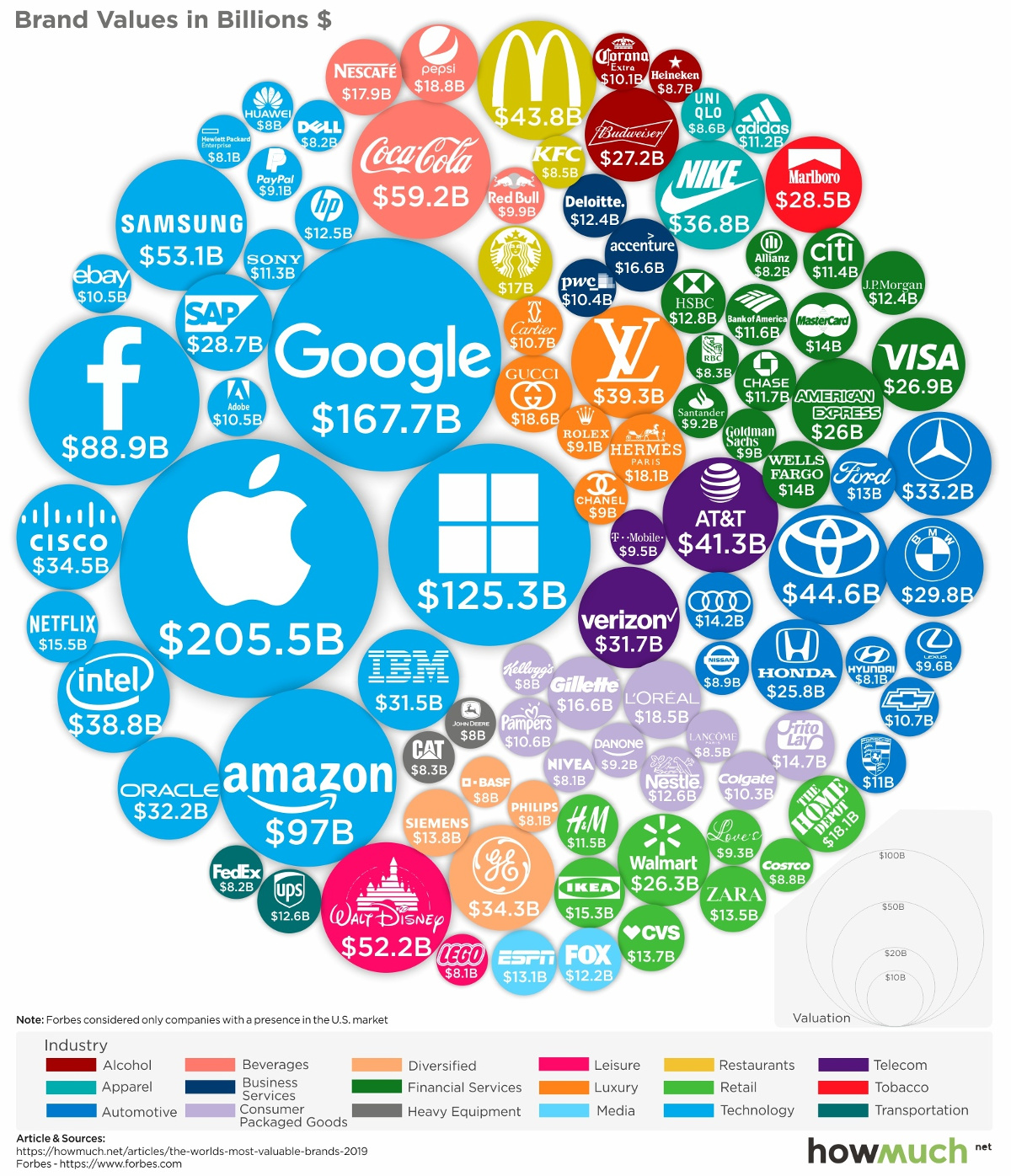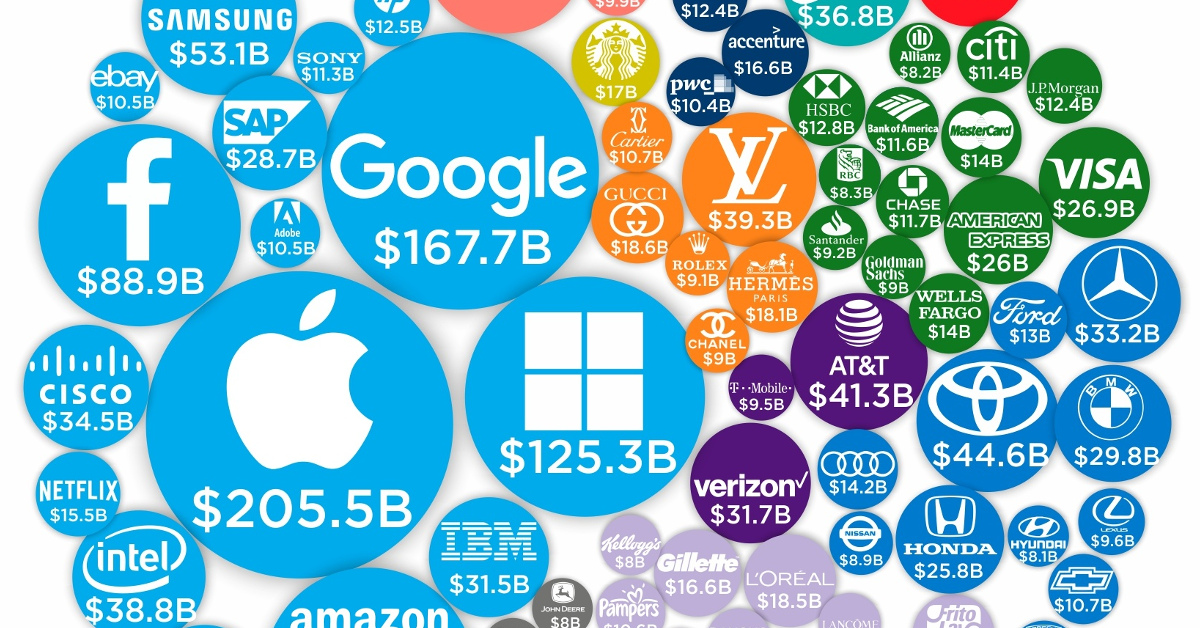Technology
The World’s 100 Most Valuable Brands in 2019

The World’s 100 Most Valuable Brands in 2019
Brand equity can be a challenging thing to build.
Even with access to deep pockets and an innovative product, it can take decades of grit to scrape your way into the mainstream consciousness of consumers.
On the path to becoming established as a globally significant brand, companies must fight through fierce competition, publicity scandals, changing regulations, and rapidly-evolving consumer tastes – all to take a bite from the same piece of pie.
Cream of the Crop
Today’s visualization comes to us from HowMuch.net, and it showcases the 100 most valuable brands in the world, according to Forbes.
Here are the powerful brands that sit at the very top of the list:
| Rank | Brand | Brand Value ($B) | 1-Yr Value Change | Industry |
|---|---|---|---|---|
| #1 | Apple | $205.5 | +12% | Technology |
| #2 | $167.7 | +27% | Technology | |
| #3 | Microsoft | $125.3 | +20% | Technology |
| #4 | Amazon | $97.0 | +37% | Technology |
| #5 | $88.9 | -6% | Technology | |
| #6 | Coca-Cola | $59.2 | +3% | Beverages |
| #7 | Samsung | $53.1 | +11% | Technology |
| #8 | Disney | $52.2 | +10% | Leisure |
| #9 | Toyota | $44.6 | +0% | Automotive |
| #10 | McDonald's | $43.8 | +6% | Restaurants |
It should be noted that the list is ordered by brand value, a measure that tries to calculate each brand’s ultimate contribution in financial terms to the parent company. You can see that full methodology here.
Finally, it’s also worth mentioning that brands with only a token representation in the United States have been excluded from the rankings. This means companies like Alibaba or Vodafone are not represented in this particular visualization.
Tech Rules Again in 2019
For another straight year, technology dominates the list of the 100 most valuable brands in 2019 – this time, with six of the top seven entries.
Most of these brands saw double-digit growth in value from the previous year, including Apple (12%), Google (27%), Amazon (37%), Microsoft (20%), and Samsung (11%). The one notable exception here is Facebook, which experienced a 6% drop in value attributed to various struggles around the company’s reputation.
Here’s a look at how industries break down more generally on the list:
| Industry | # of Brands | Brand Value ($B) |
|---|---|---|
| Technology | 20 | $957.6 |
| Financial Services | 13 | $198.1 |
| Automotive | 11 | $208.9 |
| Consumer Goods | 10 | $123.8 |
| Retail | 8 | $133.0 |
| Luxury | 6 | $124.1 |
| Beverages | 4 | $49.3 |
| Diversified | 4 | $56.8 |
| Alcohol | 3 | $69.8 |
| Apparel | 3 | $34.7 |
| Business Services | 3 | $33.5 |
| Restaurants | 3 | $73.0 |
| Telecom | 3 | $24.3 |
| Heavy Equipment | 2 | $36.7 |
| Leisure | 2 | $19.8 |
| Media | 2 | $34.8 |
| Transportation | 2 | $41.1 |
| Tobacco | 1 | $12.6 |
| Total | 100 | $2,231.9 |
As you can see, technology brands make up 20% of the list in terms of the number of entries – and a whopping 43% of the list’s cumulative valuation.
In total, technologies brands combined for $957.6 billion in value. Even when including Facebook’s recent drop, this is an impressive 9.7% increase on last year’s numbers.
Will the double-digit increases for the world’s largest tech giants continue into 2020, or are brands such as Amazon and Google going to start seeing the same type of pushback that Facebook has grappled with among consumers and regulators?
Technology
Ranked: Semiconductor Companies by Industry Revenue Share
Nvidia is coming for Intel’s crown. Samsung is losing ground. AI is transforming the space. We break down revenue for semiconductor companies.
Semiconductor Companies by Industry Revenue Share
This was originally posted on our Voronoi app. Download the app for free on Apple or Android and discover incredible data-driven charts from a variety of trusted sources.
Did you know that some computer chips are now retailing for the price of a new BMW?
As computers invade nearly every sphere of life, so too have the chips that power them, raising the revenues of the businesses dedicated to designing them.
But how did various chipmakers measure against each other last year?
We rank the biggest semiconductor companies by their percentage share of the industry’s revenues in 2023, using data from Omdia research.
Which Chip Company Made the Most Money in 2023?
Market leader and industry-defining veteran Intel still holds the crown for the most revenue in the sector, crossing $50 billion in 2023, or 10% of the broader industry’s topline.
All is not well at Intel, however, with the company’s stock price down over 20% year-to-date after it revealed billion-dollar losses in its foundry business.
| Rank | Company | 2023 Revenue | % of Industry Revenue |
|---|---|---|---|
| 1 | Intel | $51B | 9.4% |
| 2 | NVIDIA | $49B | 9.0% |
| 3 | Samsung Electronics | $44B | 8.1% |
| 4 | Qualcomm | $31B | 5.7% |
| 5 | Broadcom | $28B | 5.2% |
| 6 | SK Hynix | $24B | 4.4% |
| 7 | AMD | $22B | 4.1% |
| 8 | Apple | $19B | 3.4% |
| 9 | Infineon Tech | $17B | 3.2% |
| 10 | STMicroelectronics | $17B | 3.2% |
| 11 | Texas Instruments | $17B | 3.1% |
| 12 | Micron Technology | $16B | 2.9% |
| 13 | MediaTek | $14B | 2.6% |
| 14 | NXP | $13B | 2.4% |
| 15 | Analog Devices | $12B | 2.2% |
| 16 | Renesas Electronics Corporation | $11B | 1.9% |
| 17 | Sony Semiconductor Solutions Corporation | $10B | 1.9% |
| 18 | Microchip Technology | $8B | 1.5% |
| 19 | Onsemi | $8B | 1.4% |
| 20 | KIOXIA Corporation | $7B | 1.3% |
| N/A | Others | $126B | 23.2% |
| N/A | Total | $545B | 100% |
Note: Figures are rounded. Totals and percentages may not sum to 100.
Meanwhile, Nvidia is very close to overtaking Intel, after declaring $49 billion of topline revenue for 2023. This is more than double its 2022 revenue ($21 billion), increasing its share of industry revenues to 9%.
Nvidia’s meteoric rise has gotten a huge thumbs-up from investors. It became a trillion dollar stock last year, and broke the single-day gain record for market capitalization this year.
Other chipmakers haven’t been as successful. Out of the top 20 semiconductor companies by revenue, 12 did not match their 2022 revenues, including big names like Intel, Samsung, and AMD.
The Many Different Types of Chipmakers
All of these companies may belong to the same industry, but they don’t focus on the same niche.
According to Investopedia, there are four major types of chips, depending on their functionality: microprocessors, memory chips, standard chips, and complex systems on a chip.
Nvidia’s core business was once GPUs for computers (graphics processing units), but in recent years this has drastically shifted towards microprocessors for analytics and AI.
These specialized chips seem to be where the majority of growth is occurring within the sector. For example, companies that are largely in the memory segment—Samsung, SK Hynix, and Micron Technology—saw peak revenues in the mid-2010s.
-

 Real Estate2 weeks ago
Real Estate2 weeks agoVisualizing America’s Shortage of Affordable Homes
-

 Technology1 week ago
Technology1 week agoRanked: Semiconductor Companies by Industry Revenue Share
-

 Money1 week ago
Money1 week agoWhich States Have the Highest Minimum Wage in America?
-

 Real Estate1 week ago
Real Estate1 week agoRanked: The Most Valuable Housing Markets in America
-

 Business2 weeks ago
Business2 weeks agoCharted: Big Four Market Share by S&P 500 Audits
-

 AI2 weeks ago
AI2 weeks agoThe Stock Performance of U.S. Chipmakers So Far in 2024
-

 Misc2 weeks ago
Misc2 weeks agoAlmost Every EV Stock is Down After Q1 2024
-

 Money2 weeks ago
Money2 weeks agoWhere Does One U.S. Tax Dollar Go?












